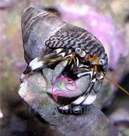Blue Leg Hermit Crab - Phimochirus operculatus - Dwarf Blue Leg Hermit - Blue Hermit - Rock Hermit

Blue Leg Hermit Crab is an interesting introduction for your marine aquarium. Its striking hue of blue, looks very beautiful when blends with the tank’s environment. This article introduces you to the various aspects of Blue Leg Hermit Crab.
Taxonomy: Blue Leg Hermit Crab belongs to the Kingdom Animalia, Phylum Arthropoda, Class Crustacea, Order Decapoda, Genus Phimochirus and Species operculatus.
Scientific names: The scientific name of Blue Leg Hermit Crab is Phimochirus operculatus.
Other common names: Blue Leg Hermit Crab is also commonly called as Dwarf Blue Leg Hermit, Blue Hermit, Rock Hermit, Polka Dotted Hermit and Equal Handed Hermit Crab.
Origin or natural range: Phimochirus operculatus is found in Caribbean, Pacific reefs throughout America, the Western Atlantic Ocean and Florida.
Size: Blue Leg Hermit Crab may grow to a size of around one inch.
Compatibility: Phimochirus operculatus is semi-aggressive towards the other marine aquarium invertebrates.
Habit & Habitat:
- Blue Leg Hermit Crab lives in groups on coral reefs or in sand along the sea shore.
- Sometimes Phimochirus operculatus is found on corals also but it does not harm them.
- Blue Leg Hermit Crab is an invertebrate, that is, it lacks a vertebral column.
- As imperative from the name, the five pairs of jointed legs of Phimochirus operculatus are blue in color with a touch of red, white and black colors as well on them.
- The first pair of Blue Leg Hermit Crab is developed into large claws, scientifically known as pincers or chelipeds, and has polka dot pattern in red and white all over.
- The last two pairs of legs of Phimochirus operculatus are quite small in size.
- The flat body of Blue Leg Hermit Crab is also blue in color as are its two eyes situated at the tip of stalks.
- The exoskeleton of Phimochirus operculatus basically supports its body framework rather than protecting the crab from its predators.
- Blue Leg Hermit Crab has two pairs of antennae which are sensory in nature.
- The abdomen of Phimochirus operculatus is twisted and soft enough that the crab can contract it and hide it inside its carapace.
- Blue Leg Hermit Crab is not a true crab and does not have a hard shell. Instead of generating its own shell, Phimochirus operculatus finds some old shell, especially whelk shells, fitting its size.
- Temperature of water: The temperature of marine aquarium hosting Phimochirus operculatus should range between Seventy-two and seventy-eight degrees Fahrenheit.
- Specific gravity of water: Blue Leg Hermit Crab requires the specific gravity of water in your marine aquarium to be within 1.023 to 1.025.
- pH of water: The pH of water in your marine aquarium should scale between 8.10 and 8.40 for the comfort of Phimochirus operculatus.
- Habit & habitat:
- To host Blue Leg Hermit Crab, you should have a reef type marine aquarium with a decent bed, enough algae and ample shells in it.
- Blue Leg Hermit Crab keeps the marine aquarium clean by eating away the detritus and micro-algae in it.
- Phimochirus operculatus also improves aeration in the substrate in your marine aquarium by its nature of continuously changing its position on the substrate.
- Feeding & Nutrition: Blue Leg Hermit Crab is Omnivorous and a scavenger in feeding habit and eats detritus, micro-algae including green hair algae and cyanobacteria and the meaty bits of seafood.

Before Placing Your Order
Store InformationShipping Info
Payment Info
Return Policy
Arrive Alive Guarantee
Adoptation Policy
After Placing Your Order
Track Your OrderSecurity Safe Shopping
Compatibility Chart
Shoppers Review










